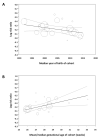Male Disadvantage in Oxidative Stress-Associated Complications of Prematurity: A Systematic Review, Meta-Analysis and Meta-Regression
- PMID: 34573122
- PMCID: PMC8465696
- DOI: 10.3390/antiox10091490
Male Disadvantage in Oxidative Stress-Associated Complications of Prematurity: A Systematic Review, Meta-Analysis and Meta-Regression
Abstract
A widely accepted concept is that boys are more susceptible than girls to oxidative stress-related complications of prematurity, including bronchopulmonary dysplasia (BPD), retinopathy of prematurity (ROP), necrotizing enterocolitis (NEC), intraventricular hemorrhage (IVH), and periventricular leukomalacia (PVL). We aimed to quantify the effect size of this male disadvantage by performing a systematic review and meta-analysis of cohort studies exploring the association between sex and complications of prematurity. Risk ratios (RRs) and 95% CIs were calculated by a random-effects model. Of 1365 potentially relevant studies, 41 met the inclusion criteria (625,680 infants). Male sex was associated with decreased risk of hypertensive disorders of pregnancy, fetal distress, and C-section, but increased risk of low Apgar score, intubation at birth, respiratory distress, surfactant use, pneumothorax, postnatal steroids, late onset sepsis, any NEC, NEC > stage 1 (RR 1.12, CI 1.06-1.18), any IVH, severe IVH (RR 1.28, CI 1.22-1.34), severe IVH or PVL, any BPD, moderate/severe BPD (RR 1.23, CI 1.18-1.27), severe ROP (RR 1.14, CI 1.07-1.22), and mortality (RR 1.23, CI 1.16-1.30). In conclusion, preterm boys have higher clinical instability and greater need for invasive interventions than preterm girls. This leads to a male disadvantage in mortality and short-term complications of prematurity.
Keywords: bronchopulmonary dysplasia; female advantage; intraventricular hemorrhage; male disadvantage; mortality; necrotizing enterocolitis; oxidative stress; periventricular leukomalacia; preterm birth; retinopathy of prematurity; sex differences.
Conflict of interest statement
The authors declare no conflict of interest. The views expressed in this paper are those of the authors and do not necessarily reflect the policies of Statistics Netherlands.
Figures



References
Publication types
LinkOut - more resources
Full Text Sources
Miscellaneous

